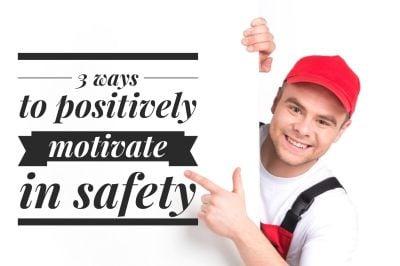Instead of focusing on negative outcomes, re-frame communications to be more positive in safety.
 Safety, like any other message or idea, needs to be marketed to employees. Safety needs reminding. The more a safety message is repeated, the more employees become comfortable with the message.
Safety, like any other message or idea, needs to be marketed to employees. Safety needs reminding. The more a safety message is repeated, the more employees become comfortable with the message.
The overwhelming focus of safety marketing in past has been wrong. Scare tactics, sad stories and data charts do not provide inspiration or motivation to buy-in to safety. They create fear and accident avoidance. That's a short-term result that needs to be constantly fed and reinforced.
Safety is focused on achieving compliance instead of developing an affinity with personal values. A cop at the side of the highway causes short-term compliance. Values alignment creates safety buy-in so that cops become unnecessary.
Instead of focusing on negative outcomes, re-frame communications to be more positive in safety. Here are three ways you can begin to re-frame how you communicate your safety message:
1Shift away from behavior-avoidance. Negative-based safety messages of “don’t do this” focus on behavior-avoidance. People want to know what they should do - not what they shouldn’t do. “Don’t do this” is not a complete set of instructions. You don’t go to the grocery store with a list of things not to buy. You don't buy-in to a financial plan because of what you might lose. You don't buy-in to a healthy lifestyle because of what you might lose. You do those things because of what you will gain. But safety is focused on reminding workers of what they might lose if they don't comply. Broke people don’t get invited to speak at financial planner conferences. Fat people don’t get to offer their “don’t do what I did” advice to fitness trainers. People don’t want to know what NOT to do. They want a plan and strategy for success - one that builds on strengths and teamwork - not negativity and fear. Show your people how safety makes life better. What exactly would you like your people to do better? Be specific about what you want them to do. Point all of your energies at accomplishing that.
2Remove irrelevant messages. At a safety meeting, the safety manager ended with a gut-wrenching video of injury. After the video, one employee stood up and asked why they shown the video? The employee pointed out its irrelevance. The story happened twenty years ago. The events depicted in the video could not happen at this company because there are too many checks and balances. The safety manager was embarrassed. Employees know what makes them respond positively. They know when they're being manipulated. You don’t build a solid safety culture by appealing to a fear of failure. So remove the negatively-reinforced and irrelevant messages from your workplace. Especially from your PowerPoint slide deck. Be relevant. Lay out your specific plan of what you want your people to do. Then sell only that message. Do not try to add shock-value or scare tactics. It confuses what you’re trying to do.
3Ask them to take ownership of the safety program. In sales, the person who doesn’t ask the customer for the sale rarely gets it. Safety is the one thing that everyone can agree on. No one wants to see someone else get hurt. Your people are on the same page as you in that regard. So, you assume that you shouldn’t have to ask them to “buy” in to safety, right? But, because they’ve never been asked, they treat safety as rules they are forced to follow. So ask. Show them how safety makes their lives better. Your people may have plans for when they retire but how many have a plan to make it safely to retirement age? I mean, a real plan that they execute each day? The safety plan, when worked properly, will get your people successfully to retirement age. If your people want to enjoy their golden years healthy and happy, then they are going to need a plan to safely get there. Ask them to buy-in to the safety plan.
 Inspire your people and value them. Trust them, involve them and engage them in all aspects of safety. Allow them to buy-in to safety for the long-term. Don’t forget to ask them though. Show them that safety is enjoyable. Keep it positive. Once you get buy-in, it lasts a lifetime.
Inspire your people and value them. Trust them, involve them and engage them in all aspects of safety. Allow them to buy-in to safety for the long-term. Don’t forget to ask them though. Show them that safety is enjoyable. Keep it positive. Once you get buy-in, it lasts a lifetime.
Kevin Burns is a management consultant, safety speaker and author of "The Perfect Safety Meeting" and "Running With Scissors - 10 Reasons To Invest in Safety In Slow Times." He is an expert in how to get through to people and believes that the best place to work is always the safest place to work. Kevin helps organizations integrate caring for and valuing employees through their safety programs.
(c) Can Stock Photo


